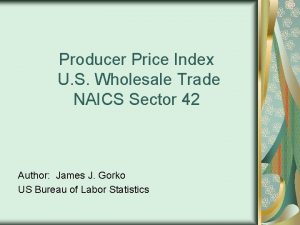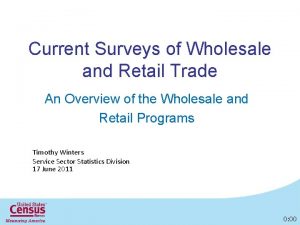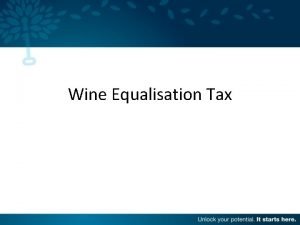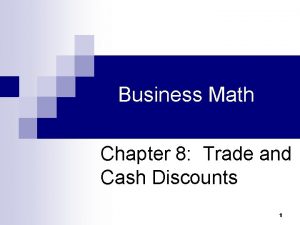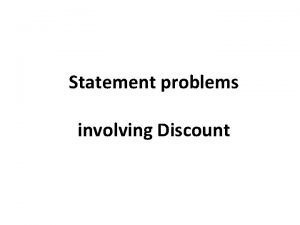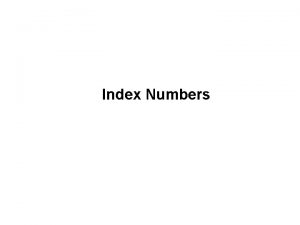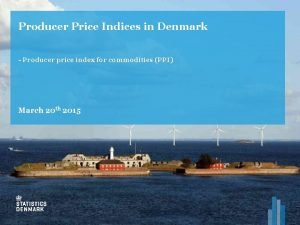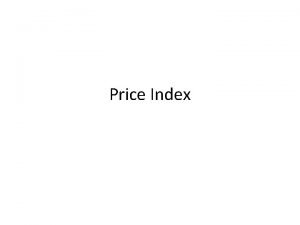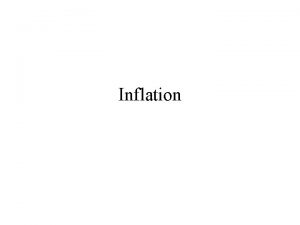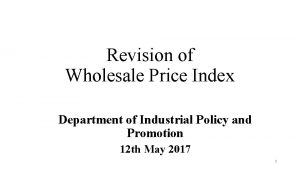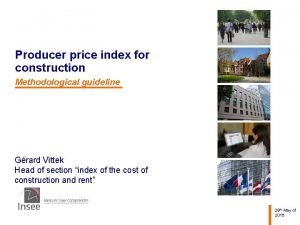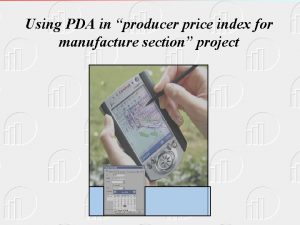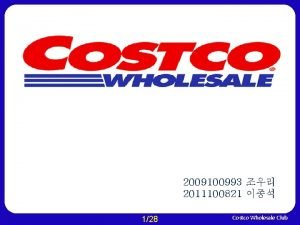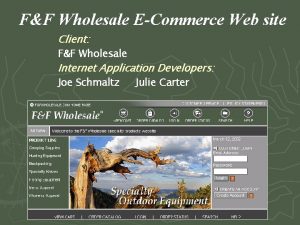Producer Price Index U S Wholesale Trade NAICS





















- Slides: 21

Producer Price Index U. S. Wholesale Trade NAICS Sector 42 Author: James J. Gorko US Bureau of Labor Statistics

Wholesale Trade Definition Efficient transfer of goods from manufacturer to another party for the strict intention of resale The creation of utility (or efficiency) Channeling function

Creation of Utility Time and place utility Making products available when and where customers are likely to find them Possession utility Allowing customers to take ownership of products as needed Information utility Providing details about the products sold

Channeling Function Selling and promoting Buying and assortment building Bulk breaking Warehousing Transportation Risk bearing Market information Management services and advice

Types of Wholesalers Merchant Wholesalers Generally take title to goods Sales Branches and Offices of Manufacturing Operations Title generally stays with manufacturer until sale is complete Agents and Brokers Generally do not take title to goods

Classification Issues NAICS versus ISIC Conceptual difference ISIC uses class of customer definition NAICS using method of selling General concordance at sector level Only two one-to-one industries (out of 17 4 -digit ISIC and 71 6 -digit NAICS) Motor Vehicle – ISIC combines wholesale and retail

Classification Issues Wholesale versus retail NAICS classifies units as retail if they have any retail selling space Majority of turnover could be wholesale but still in retail if they have retail selling space

Classification Issues Wholesale versus manufacturing Manufacturers transform materials into new products Wholesalers generally engage in breaking bulk and redistribution producing a new version of same product Contract manufacturers are not included in wholesale Manufacturer sales offices are in wholesale even if prices are set by manufacturer and title held by manufacturer

Classification Issues Wholesale versus Manufacturing Examples: Bottling – all bottling except soft drinks are in wholesale trade – soft drinks manufacturing Metal service centers saw, shear, bend, level, clean, or edge on a custom basis and are considered wholesalers Cheese grating – wholesale if they cut, grate and mix cheese. If aging or moisture reduction is included, then manufacturing

Classification Issues Scrap/Recyclable material merchant wholesales Service ISIC 4 NAICS Wholesaling of scrap without further 4669 423930 product transformation Processing of metal and non – metal waste 3830 423930 into secondary raw materials usually involving a mechanical or chemical transformation process Sorting and separating metal and non-metal 3830 waste 562920

Wholesale Trade Pricing No direct ‘fee for service’ price exist Gross margin is used to quantify the value of the trade services provided to the consumer of those same services Gross margin is defined in national accounts as the selling price of a good less the cost of replacing the good sold Excludes clearance prices

Wholesale Trade Pricing Margin prices are most prevalent prices for merchant wholesalers who generally take title to the goods (also used by manufacturers sales & branch offices) Dollar value of commission prices are most prevalent prices for agents and brokers who do not take title to the goods (also used by manufacturers sales & branch offices)

Wholesale Trade Pricing For merchant wholesalers, the margin price is calculated using the incoming acquisition price and the selling price For agents and brokers, the dollar value of commission is calculated by multiplying sales dollars by the commission percentage

Wholesale Trade Pricing Margin Pricing 1. Average gross margin per unit for a comparable customer class and/or supplier class for all sales within a comparable product line. 2. Average gross margin per unit for all customers and/or suppliers for a comparable product line. 3. Average gross margin per unit for a particular customer class and/or supplier class for all sales of a particular product. 4. Average gross margin per unit for all customers and/or suppliers for all sales of a particular product. 5. Gross margin for a single specific product transaction

Wholesale Trade Pricing Dollar Value of Commission Prices 1. Average dollar value of commission per unit for a comparable customer class for all sales within a comparable product line. 2. Average dollar value of commission per unit for all customers for a comparable product line. 3. Average dollar value of commission per unit for a particular customer class for all sales of a particular product. 4. Average dollar value of commission per unit for all customers for all sales of a particular product. 5. Dollar value of commission for a single specific product transaction

Wholesale Trade Pricing Prices as defined in SPPI Thesaurus Margin Price ? ? ? Direct use of prices of repeated services ? ? Dollar Value of Commission ? ? Percentage fees ? ?

Wholesale Trade Pricing Average Margin Pricing Homogeneous groupings of products with same marketing strategy 65% of wholesale trade respondents Particularly useful for wholesalers with rapid product change/seasonal products Caution: if product groups are not homogeneous enough or too broad, an unknown degree of error is introduced

Quality adjustment Necessary when marketing characteristics change not when product features change Marketing characteristics are difficult to quantify without hedonic model Currently only able to quality adjust if respondent identifies a marketing change and provides a quality adjustment value for that change

Comparability to Turnover Data Turnover data in greater detail than in PPI in 5 -year economic census collections Annual and monthly turnover data is not as comprehensive as 5 -year data

National Accounts Currently, U. S. national accounts publish at the three digit NAICS level only but deflate at lower levels U. S. national accounts requesting PPIs at the 4 -5 digit NAICS level to use as deflators Without PPIs for wholesale, then PPI goods prices are used assuming that margin data will equate with gross sales price data (bad assumption)

Summary Growing sector in U. S. economy Manufacturing units are outsourcing production so former manufacturing unit becomes a wholesale trade unit Important for national accounts to have accurate margin data for deflators
 Naalahamap
Naalahamap Naics code for grubhub driver
Naics code for grubhub driver Wholesale trade
Wholesale trade Wholesale trade
Wholesale trade Annual retail trade survey
Annual retail trade survey Mengelola perdagangan eceran grosir dan logistik
Mengelola perdagangan eceran grosir dan logistik Wet payable
Wet payable Tariff deadweight loss
Tariff deadweight loss Which is the most enduring free trade area in the world?
Which is the most enduring free trade area in the world? What was the triangular trade
What was the triangular trade Tramp and liner shipping
Tramp and liner shipping The trade in the trade-to-gdp ratio
The trade in the trade-to-gdp ratio Trade diversion and trade creation
Trade diversion and trade creation Fair trade not free trade
Fair trade not free trade Trade diversion and trade creation
Trade diversion and trade creation Trade diversion and trade creation
Trade diversion and trade creation Rog business math
Rog business math Hire purchase and installment system difference
Hire purchase and installment system difference Difference between reactive sourcing and strategic sourcing
Difference between reactive sourcing and strategic sourcing Price discovery and price determination
Price discovery and price determination Marked price-selling price=
Marked price-selling price= Real number
Real number


